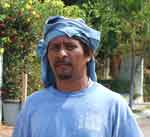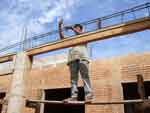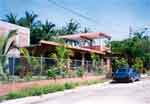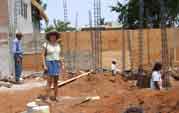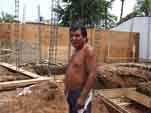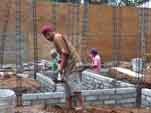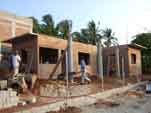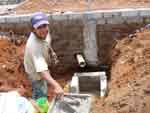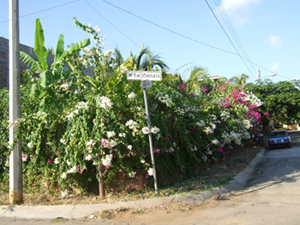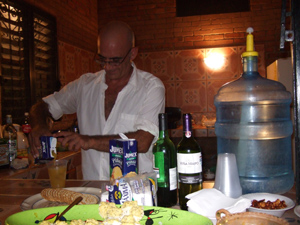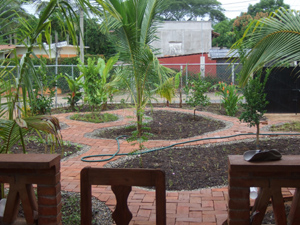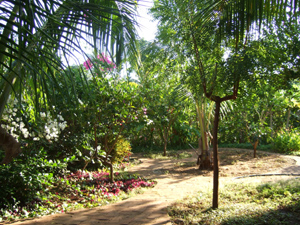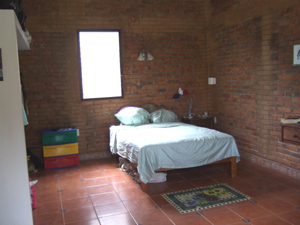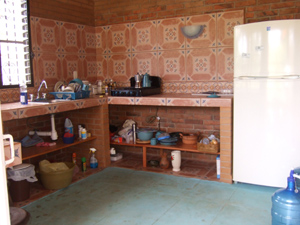|
BUYING PROPERTY AND BUILDING IN MEXICO
Buying property in Mexico, even in Puerto Escondido, is no more - or less - risky than buying it in the U.S. It's just that the risks are different. I'm writing this in September of 2007, a time at which many Americans are losing their homes because of deceptive financing arrangements. Mortgages will not be your problem in Mexico as you will be expected to pay cash for your land. There are many new developments (fraccionamientos) along the coast. The things to check for are: accessible roads, electric lines, telephone lines, water, and drainage. Typically the developer will promise all of the above, but may not provide them until all the lots are sold (if then). In Mexico fraud is a criminal offense, but you would need a lawyer to pursue the case, which would drag on for years. Even buying a lot in a neighborhood where there is electricity does not guarantee that you will have a hook-up. An electric pole costs around $5,000 and you might need a bunch of them to reach your property. A transformer is also a few thousand dollars. The electric company can tell you if the lot you want to buy is ready to be put on the grid or not. In a lot of areas, road building and road maintenance is the responsibility of the local community which typically votes an assessment on the property owners. This, plus the ravages of the rainy season, explains why there are so many unpaved and poorly maintained roads. The fewer houses there are the less likely it is that your road will be maintained. More worrisome are properties that by law
(i.e. the Mexican constitution) cannot be sold to foreigners. This is
any property within 50 kilometers of the coast or 100 kilometers from
an international border. There is a legal instrument, however, that
allows foreigners to get around this restriction - the fideicomiso
[fee-day-co-MI-so]. The fideicomiso is a bank trust which holds the
title to the land in your name. With a fideicomiso you can sell your
property at any time to a Mexican or to another foreigner. The fideicomiso
is for 50 years and is renewable. The bank does nothing for you except
hold the title in trust; for that service you pay around $500 a year
plus $75.00 in federal taxes. Real estate taxes are very low - only
0.1% of the assessed value at time of purchase. Many foreigners do build their houses on communal land. Some buy land with the help of a Mexican national. Typically, and sometimes for a fee, the Mexican puts the property in his name and signs a contract giving you full use of the land. The nominal owner in this agreement is called a presta nombres (name-lender). The problem is that this contract is not lawful; it will not hold up in court. If the name-lender dies, his heirs can claim the property. For immigration visa purposes, you are a renter, not a homeowner. The situation can get complicated when you need the name-lender's signature on an official document when he happens not to be in town. Ultimately, you have to ask yourself how much risk you are comfortable with. The other alternative is to form a Mexican corporation. Mexican corporations can buy communal land and they can be 100% foreign owned. The downside is that the property has to be developed commercially; it cannot be used solely as your residence. If you are planning to rent out your house part of the year or to rent rooms, this may be a good option. Speak to an accountant first. Even if you have a fideicomiso, you are expected to pay taxes on any rental income. For obvious reasons, private land tends to be more costly than communal land. But even having a bank trust does not guarantee that there will not be problems; it does however greatly diminish the risk. Currently (2007), some condos near the beach, which do have fideicomisos, are under dispute and a judge has ruled that none of the units can be sold until the matter is resolved. It seems that the land was usurped from its owner by a developer in cahoots with local and state politicians. The case traveled through the courts for years, and the landowner won. Now the question is who is to pay him and how much. Even in the nicest, costliest neighborhoods of Puerto Escondido, one cannot help but notice the number of half built and seemingly abandoned houses there are, very few of which are for sale. Presumably the owners ran out of money or plan to build in stages according to their means. Rule of thumb: whatever you plan to spend, be sure to have an equal amount in reserve. Architects and contractors, both scrupulous and unscrupulous, are notorious for underestimating the real cost of labor and materials. Plus you will find that every change you make to the original plan will be billed at a higher rate than the original per-meter cost. So don't fall for the architect's "you can always change it later" routine. Abandoned construction sites always give me pause as I imagine each owner started out as optimistically as I did. BARBARA'S TIPS FOR BUYING PROPERTY AND BUILDING
Some of the following tips are so basic that I'm embarrassed to write them. However, there is something about a tropical climate, ocean sunsets and tequila that makes even the most prudent people take leave of their senses. 1) There is no such thing as an earthly paradise. Watch your wallet both literally and figuratively. 2) Everything can be negotiated; people are more flexible than you might think. If someone says, "this is the way it's done," you can respond with, "this is the way I do things." If an architect insisted on my paying 50% up front, I would look for another architect. After all, he could drop dead tomorrow and my contract would just be a claim on his estate. 3) Realtors and developers are salespeople. Some will wine and dine you, but it's still all about doing business. In Puerto Escondido, it seems like every other person has properties for sale, which means they know someone from whom they can get a commission on a sale. Sometimes there is a whole chain of commissions between the buyer and the seller.
4) Before you put out any money, have a lawyer or notary write up the purchase agreement. If the seller doesn't want to deal with the lawyer, you know you have a problem. There is no system of escrow accounts per se in Mexico, but the notary can hold the initial payment. The final payment should be made at the notary's office at closing, when the fideicomiso has been approved and paid for. This process usually takes three to four weeks. 5) Architects sometimes manage construction, but it's a lot cheaper to just pay an architect to draw up the plans (you will need them to get a building permit) and then hire a contractor/builder. It is extremely important to get multiple bids and to get references from former clients. It is not unheard of for an architect or builder to claim credit for someone else's house, so be sure to speak to the owner. 6) Pay for the materials yourself. My contract with my builder was just for labor (mano de obra). The local building supplier, Zimat, gave me a line of credit so that the builder could order whatever he needed whenever he needed it; all I had to do was write the checks. One hears too many stories of people being ripped off by architect/contractors using inferior materials and charging for more expensive ones. Some contractors just add a percentage of the materials cost to the building cost as part of the contract. This system does not encourage the contractor to look for the best deals.
7) Try to get a pay-as-you-go contract. I paid for my house in five installments for amounts agreed on before construction started. The first installment was for the foundation. When that was finished I paid for the walls, next I paid for the roof. This system is much better than paying by the week which gives the workers no incentive to finish in a timely way. 8) Find out how large a crew will be working on your house and if they will be there everyday until completion. There were at least eight workers plus the builder/contractor on my site five-and-a half or six days a week. My house was completed in 11 weeks. 9) Everything costs money. Building a house in Mexico is relatively cheap; it becomes a lot more expensive when you put in the "finishings" (terminaciones): plaster and paint, windows, doors, iron grill work, tile floors, kitchen and bathroom fixtures. This is where everyone goes over budget, which is why you need to have money in reserve. 10) Visit the construction site as often as possible. I usually drove by at least once a day. It was a good thing I was there when the electrician was about to put in the connections for the ceiling lamps. I hadn't noticed that they were in the architect's plans; he had never consulted me about them. I wanted wall fixtures and that's what I got. The bathroom was another story. They were ready to put up the walls when I realized it was too small. (If I knew how to think in meters, I might have caught the problem when I read the architectural plans.) Luckily, I was able to make the bathroom a mi gusto by taking a meter out of the guest room. Of course, it added to the construction cost. 11) Know how to say "no", but listen to advice. The architect acted like I was a fool when I said I wanted one bathroom not two. He kept saying how cheap it would be and that I needed my privacy. What nonsense! Of course two bathrooms cost more than one. I live alone, and I have no problem if guests use my toilet. Fortunately, I was dissuaded from my idea of having a laminated roof over some of my rooms instead of cement. I was adamant, however, about having an inexpensive fiberglass roof for the upstairs deck and the front porch and that has worked out very well.
|
||
|
THE PURCHASE AGREEMENT A purchase agreement (contrato privado de promesa de compraventa) is typically a boilerplate two-page document prepared by a lawyer or a notary. It states the seller's and the buyer's name, address, age, marital status and other particulars. It also states the exact size and location of the property as it appears on the deed. The agreement must show the amount actually to be paid including the down payment which is paid at the signing of the agreement. For tax purposes - or to avoid paying more taxes than necessary - the seller may request that the declared purchase price be less than the actual purchase price. (The capital gains tax is 15%; 28% for foreigners.) In this case, both amounts must appear in the purchase agreement. (If the purchase agreement is written by a notary and the declared price is not the purchase price, be sure to request that the document not be notarized, i.e. entered into the public record.) The date of initiation of closing must also be declared. My purchase agreement allowed for three weeks to lapse before the title transfer process would be initiated with a notary. This was the amount of time that the seller would need to get a certificate of non-encumbrance (certificado de no gravamen) from the deed office and that the buyer might need to get his papers in order. If the sale does not go through because the seller does not present the paper work to the notary by the agreed upon date, he must return the deposit to you. Remember: an oral agreement is as good as the paper it's written on.
|
||
|
THE FIDEICOMISO It took 16 working days from the time I paid the notary (after the seller had provided the below mentioned papers to the notary) to the closing date. Closing occurs after the bank approves the fideicomiso and the buyer has paid the bank fees. The State Department fee and the taxes are handled by the notary. At the closing the seller and buyer (or their proxies) sign papers at the notary's office and, unless other arrangements have been made, the buyer pays the seller for the property. At this point the buyer receives a stamped letter saying that the fideicomiso for this property is being processed. This letter is the functional equivalent of a fideicomiso and you can use it to get a building permit. The actual fideicomiso paper is a thick document which you will receive around a month after closing. If the seller is a foreigner and there
is already a fideicomiso, the fideicomiso is merely transferred to the
new owner. This saves you time and money. If you later sell your property
to a Mexican national or to a Mexican corporation, the fideicomiso is
dissolved and the new owner receives clear title (escritura). (Information courtesy of Notaria Pública No. 57, Puerto Escondido, Oaxaca) The SELLER must provide the notary with
the following documents: - A receipt showing that the current year's
property tax has been paid. - If there is a house and the house has been the residence of the owner: receipts for the payment of utilities. -The bank that will administer the fideicomiso
may require other documents. The BUYER must provide the notary with
the following documents: -The bank that will administer the fideicomiso
may require other documents. If the buyer and/or seller is represented by a proxy with power of attorney given outside of Mexico, the power of attorney must be apostilized or have a consular certification. FEES: Buyer's costs: Notary fees - 12,000 pesos, half payable at the start of the process, half at the end. (This is what my notary charged in May 2007.) State Department (Secretaria de relaciones exteriores) - 11,800 pesos for permission to establish a fideicomiso. State Department: 3,196 pesos for inscription in the Registry of Foreign Investments. Bank fees: $1,150.00 U.S. (tax included) $500.00 is for setting up the fideicomiso; $500.00 for the first annual payment; $150.00 federal tax. Transfer tax (traslado de dominio). 3% of the cost of the property or of its assessed value, which ever is higher. Seller's cost: The seller must pay the capital gains tax (ISR) at the time of the sale.
|
||
